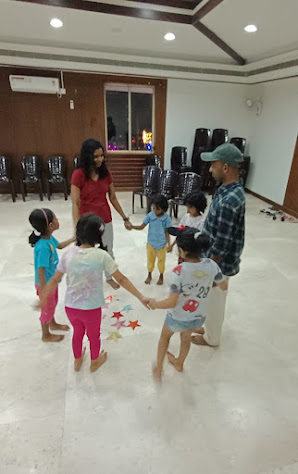Exploration of forms through vision, touch and feel
We started with hello song and as warm up, we played tom and jerry. This is an interesting game which encourages random pair formation among children and sudden role reversal of prey into predator and vice versa. We have observed that sometimes kids have strong preferences for who their partner is, and we want to consciously soften this pattern so that bonding across the group is more uniform. Games in which partners come together and disperse, is being used as a tool to achieve this.
After the game, we moved towards the core activity of the session, which was to figure out an object just from its touch and feel sensations. We had collected a bunch of day to day objects such as animal forms, models of furniture, utensils, vehicles etc.. We blindfolded the children one by one, and gave one object in their hand, and asked them to figure out what that is.( We used different blindfolds for individual children, in order to maintain hygiene.) They had to feel the object with their fingers and understand how it feels, and find out what that is. Children enjoyed this so thoroughly, and we played this for about three rounds, exhausting time for the next activity. So we just asked them to draw one of their favourite object from what they figured out by themselves. We used charcoal as a medium, considering its rich textured feel, which goes well with our theme.
Our world is made of objects, both natural and artificial. When we encounter these objects in day to day life, there is a certain mundaneness about them, and we often don't care enough to pay close attention to how they are designed and why they are there. If we just take the simple case of a chair, there is a rich possibility to look at it in terms of its aesthetics, comfort of back support, hip support, weather legs hang down or stay grounded on floor, weather the touch of material (metal/wood/other) is comfortable on skin, balance etc. Each of these are connected to a different sensory aspect of our perception. The first step to bringing our consciousness into how everyday objects are designed, is to open up to their existence in our life and to pay close attention to details of their form and function.
However there is a possibility that just the sense of vision overrides so many other more subtler sensorial perspectives. When we use blinding, we are facilitating these aspects to come forth and engage in making sense of the world. This is one reason, so many times, we close our eyes when in meditation.
.jpeg)



Comments
Post a Comment